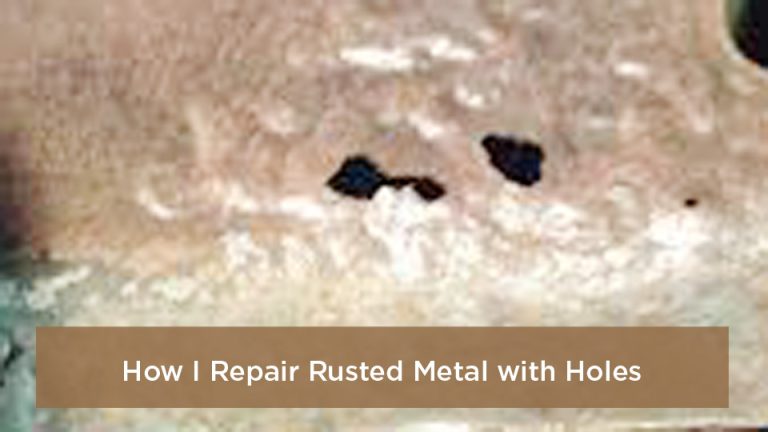I’ve lost count of how many times I’ve walked into the shop, ready to start a weld, only to find a piece of mild steel covered in rust. It’s a common frustration, whether you’re running MIG vs TIG, setting up filler rods for stainless welding, or dialing in arc control for thicker plate joints—rust always throws a wrench in the process. I remember a buddy once asking me, “Can you just slap Rustoleum over rust and call it good?” and that question stuck with me.
On one hand, paint might seem like a quick fix to save time and money, but in welding and fabrication, shortcuts on surface prep can cost you in weld quality, joint strength, and even safety. That’s why understanding if—and when—you can put Rustoleum over rust is so important for anyone working with metal. Stick with me, because in this guide I’ll break down what really works, what doesn’t, and how to make sure your project holds up in the real world.

Image by fb
Rust and Its Impact on Welding
Rust is essentially iron oxide, that flaky red stuff that forms when steel or iron reacts with oxygen and moisture. It’s a natural process, but it accelerates in humid environments or when metal’s exposed to salt, like on vehicles in snowy states.
How Rust Forms on Metal
You’ve got a scrap piece of mild steel left outside. Water hits it, oxygen mixes in, and boom—electrochemical reactions kick off, turning solid metal into brittle oxide layers. I’ve seen it happen overnight on job sites near the coast. Factors like temperature swings, pollutants, or even poor storage speed it up. For welders, this means the surface you’re working on isn’t uniform anymore; it’s pitted and contaminated.
Why Rust is a Problem for Welds
Rust messes with weld quality big time. It introduces contaminants that can cause porosity—those tiny holes in your bead that weaken the joint. From my experience, welding over heavy rust often leads to incomplete fusion, where the weld doesn’t bond properly to the base metal. This reduces strength and can lead to cracks under load. Plus, rust burns off during welding, creating extra fumes that aren’t great for your lungs.
Safety-wise, it’s a no-go if you’re working on anything load-bearing, like frames or supports, where integrity is key. Cost-wise, skipping proper prep might seem efficient, but redoing a failed weld eats up more time and filler material than cleaning it right the first time.
Can You Really Weld Over Rust?
Alright, let’s tackle the big question head-on, as if we’re chatting over coffee in the break room. Can you weld over rust? In short, yes, but with caveats. I’ve done it in pinch situations, like emergency repairs on farm equipment where grinding everything clean wasn’t feasible. However, it’s rarely ideal.
The Short Answer
Technically, certain welding processes can penetrate light rust, but heavy corrosion? Forget it. You’re not welding rust—you’re welding the metal beneath, and rust gets in the way. Clean metal always gives better results.
When It Might Be Okay
If the rust is just surface-level scale and your project isn’t critical—like tacking together a non-structural bracket—you might get away with minimal prep. I’ve used this approach on quick fixes for garden tools or decorative pieces. But for anything that needs to hold weight or withstand vibration, like trailer hitches or machinery parts, always aim for bare metal.
Risks and Downsides
The downsides are real. Porosity from rust inclusions can make your weld brittle, leading to failures. I’ve seen beads crack because rust trapped moisture, causing hydrogen embrittlement. Spatter increases, making cleanup a pain, and fumes can cause metal fume fever— that nasty flu-like feeling after inhaling too much.
In professional settings, ignoring rust could violate welding codes, like those from the American Welding Society, risking inspections or liability. Bottom line: weigh the risks against the rush.
Preparing Rusty Metal for Welding
Prep work is where the magic happens, or where projects go south if you skimp. I always tell new trainees: 80% of a good weld is in the preparation. Let’s break it down step by step.
Step-by-Step Rust Removal Guide
First, assess the rust. Light flaking? A wire brush might suffice. Heavier buildup needs more aggression.
- Safety first: Don your PPE—gloves, respirator, eye protection. Rust dust is no joke.
- Knock off loose rust with a hammer or chisel to reveal the extent.
- Use a wire brush or cup brush on an angle grinder for surface cleaning. Work in sections to avoid overheating.
- For stubborn spots, switch to a flap disc or sanding wheel. Aim for shiny metal.
- If it’s pitted, consider grinding deeper, but watch material thickness—you don’t want to thin it out.
- Chemical removers like rust converters can help on awkward shapes, but rinse thoroughly to avoid residue.
- Wipe with a clean rag and solvent like acetone to remove oils.
I’ve used this process on countless rusty pipes; it takes elbow grease but pays off in smooth beads.
Tools and Materials Needed
Stock your kit with: angle grinder with wire brushes and flap discs, hammer, chisels, sandpaper (80-120 grit), rust remover spray, and PPE. For bigger jobs, a needle scaler or sandblaster saves time. In my shop, I keep a dedicated rust-busting station to streamline this.
Common Mistakes in Prep Work
One big mistake is rushing—brushing once and calling it good, only to get porous welds. Another is over-grinding, creating thin spots that burn through. I’ve fixed my share of those by practicing on scrap. Also, forgetting to clean both sides of the joint; rust on the back can still cause issues. Tip: Test your prep by running a quick bead on a sample piece.
Best Welding Processes for Dealing with Rust
Not all processes handle rust the same. Based on years of trial and error, here’s what works best.
Stick Welding (SMAW) on Rusty Surfaces
Stick is forgiving on dirty metal. The flux coating helps burn through light rust, creating slag that protects the weld pool. I’ve used it outdoors on rusty fences where MIG would struggle with wind. It’s great for beginners too—simple setup, no gas needed.
MIG Welding (GMAW) Tips for Rusty Metal
MIG is fast but picky about cleanliness. Solid wire struggles with rust, leading to erratic arcs. I’ve learned to crank up the voltage a bit for better penetration, but prep is key. Use ER70S-6 wire for its deoxidizers—they help with minor contaminants.
Flux-Cored Arc Welding (FCAW)
This is my go-to for rusty jobs. The flux inside the wire handles rust better than solid MIG, producing less spatter and deeper penetration. Self-shielded versions don’t need gas, perfect for field work. I’ve repaired rusty truck frames with FCAW, saving hours.
TIG Welding (GTAW) Considerations
TIG demands spotless metal—rust will contaminate the tungsten and ruin your bead. Reserve it for clean, precision work like aluminum or thin stainless. If rust’s involved, thorough grinding is non-negotiable.
Rod Types and Filler Materials for Rusty Jobs
Choosing the right filler is crucial for compatibility and strength.
Recommended Electrodes for Stick
For rusty steel, 6010 rods are champs—they dig deep and handle contaminants. I’ve used them on pipeline repairs with minimal prep. 7018 is better for clean, high-strength welds but needs drier conditions to avoid porosity.
Wires for MIG and Flux Core
ER70S-6 for MIG on mild steel with light rust—its silicon and manganese fight oxidation. For flux core, E71T-1 wires offer good penetration on dirty surfaces. Match wire diameter to your machine; 0.035-inch is versatile for hobbyists.
Machine Settings and Techniques
Settings make or break your weld on rusty metal.
Adjusting Amps and Voltage
For MIG on rusty mild steel (1/8-inch thick), start at 18-20 volts and 150-200 amps, adjusting higher for penetration. Stick with 6010? 90-120 amps for flat positions. Test on scrap—rust can change arc behavior, so dial in for stable puddle.
Joint Preparation on Rusty Pieces
Bevel edges on thicker rusty pieces for better fusion. Use a backing strip if rust has thinned the metal. I always clamp tightly to minimize gaps, which rust exacerbates.
Safety Considerations When Welding Rusty Metal
Safety isn’t optional. Rust fumes can irritate lungs, so use a respirator with P100 filters. Ventilate your space—I’ve installed exhaust fans in my shop after one too many headaches. Protect skin from sparks, and ground properly; rusty surfaces can cause poor connections, leading to shocks. Follow OSHA guidelines for fume exposure, especially in confined spaces.
Real-World Applications and Examples
Let’s get practical with stories from the field.
DIY Projects
For hobbyists, welding rusty angle iron for a workbench? Clean key areas and use flux core for quick bonds. I once built a garden trellis from salvaged rusty rebar—light prep and stick welding did the trick, holding up for years.
Professional Repairs
On job sites, I’ve welded rusty I-beams in warehouses. Thorough grinding ensured code compliance. For auto body work, removing rust prevents future corrosion under paint.
Pros and Cons of Welding Over Rust vs. Cleaning
Here’s a quick comparison to help you decide:
| Aspect | Welding Over Rust | Cleaning First |
|---|---|---|
| Time | Faster initially | More upfront effort |
| Weld Strength | Weaker, prone to failure | Stronger, reliable |
| Cost | Lower material use short-term | Saves on rework long-term |
| Safety | Higher fume risks | Reduced hazards |
| Applications | Quick, non-critical fixes | Structural, load-bearing |
Pros of skipping clean: Speed in emergencies. Cons: Compromised integrity. Always clean for pros.
Alternatives to Welding Rusty Metal
If welding’s too risky, consider bolting or riveting for temporary fixes. For severe rust, replacement is best—I’ve scrapped pieces that were beyond saving to avoid disasters. Rust converters can stabilize surfaces before welding, but they’re not miracles.
In wrapping this up, the key takeaway is that while you can weld over rust in some cases, proper prep leads to better, safer results. You’re now equipped to assess your metal, choose the right process, and avoid pitfalls that could ruin your project.
Whether you’re a student learning the ropes or a pro refining techniques, this knowledge builds confidence. Always keep a rust removal kit handy—it’ll turn potential headaches into smooth sessions.
Can MIG Weld Over Rust?
MIG can handle light rust with the right wire and settings, but it’s not ideal. Flux-cored wire penetrates better than solid, reducing spatter. Clean as much as possible for strong bonds.
Is It Safe to Weld Rusty Metal?
It’s safe if you prep properly and use PPE, but rust fumes can cause irritation or fever. Ventilate well and avoid confined spaces without extraction.
What Happens If You Weld Over Heavy Rust?
Heavy rust leads to porous, weak welds that may crack. It increases spatter and reduces penetration, compromising the joint’s durability.
Best Way to Remove Rust Before Welding?
Grind with an angle grinder and flap disc for best results. For light rust, wire brushing works; chemicals help on curves. Always aim for bare, shiny metal.
Can Stick Welding Burn Through Rust?
Yes, rods like 6010 are designed for it, with flux helping remove contaminants. It’s great for outdoor or dirty jobs, but test settings first.



